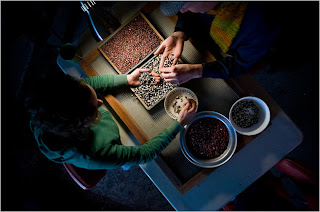 |
| Both paintings by Grant Wood 1931 |
I was thinking about the romanticized images of rural life that typify the paintings of Grant Wood. And while Wood had an obvious affection for the land and it's bounty, today his paintings portray what seems to be a long-vanished vision of America.
Back in the 1930's, when this art was created, many Americans found their livelihood working the family farm. And life portrayed in these images was much more common. All that changed with the industrialization of agriculture, the growth of Agri-business and the food and farming conglomerates like ADM and Cargill. A generation ago, the news was all about family farms being auctioned and the loss of a way of life.
 |
| Tyler and Alicia Jones on their farm Photo: Leah Nash NYT |
 |
| Cleaning heirloom beans Photo: Leah Nash NYT |
But this post is about rebirth, not death. Although, you could argue that new life often arises from ashes. And so it seems with the new breed of farmer.
They're young, idealistic, inspired by "foodies" and our new interest in food as well as concerns about how it's produced. You could even argue this is a values movement, as people question where their food comes from, its' safety, the use of antibiotics and pesticides, and the environmental cost of large scale agriculture. Michael Pollan could be their patron saint. A quick window into his thinking can be found at this piece he created on food rules.
Community Supported Agriculture forges a direct path between farmer and consumer. The idea migrated here from Europe in the early 1980s. And while it once urged that bigger is better, now even the USDA supports it. So today, in a new "back-to-the-land" movement, there are farmers growing heirloom vegetables, small batch "artisan" cheeses, grass-fed animals raised without hormones or antibiotics, and other organic originals. Vermont just initiated a small business start-up award specifically for food and agriculture. My wife and I are doing a CSA, as are our kids, one in VT, the other in NY.
 |
| Antique gear like this 1950's tractor are again in demand Leah Nash NYT |
A recent NYT piece on the new farmer movement in Oregon describes how they've turned their back on industrialized, mechanized farming in favor of a more hand-crafted approach. The head of the local grange is 26 and now has yoga classes once a week. The average age of farmer-members has dropped from 65 to 35. You can say it's a new way of thinking about what and how we eat, inspired by an old way of bringing food to the table.
















